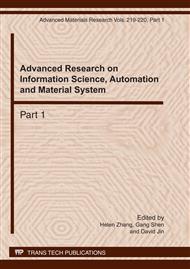[1]
Web Services Architecture Requirements Working Group, http://www.w3.org/TR/wsa-reqs, (2004).
Google Scholar
[2]
Dustdar S, Schreiner W, Schreiner W. A survey on Web services composition. Int'l Journal of Web and Grid Services, 2005,1(1):1-30.
DOI: 10.1504/ijwgs.2005.007545
Google Scholar
[3]
Milanovic N, Malek M. Current solutions for Web service composition. IEEE Internet Computing, 2004,8(6):51-59.
DOI: 10.1109/mic.2004.58
Google Scholar
[4]
Shamim H. Ripon. Process Algebraic Support for Web Service Composition[J], ACM SIGSOFT Software Engineering Notes, Vol35,2010 (2).
DOI: 10.1145/1734103.1734118
Google Scholar
[5]
Munindar P. Singh, Distributed enactment of multiagent workflows: temporal logic for web service composition, Proceedings of the second international joint conference on Autonomous agents and multiagent systems, July 14-18, 2003, Melbourne, Australia.
DOI: 10.1145/860575.860721
Google Scholar
[6]
B. Srivastava. Automatic Web Services Composition Using Planning. In Proceedings of KBCS, Mumbai, 2002, pp.467-477.
Google Scholar
[7]
Sirin, E., et al., HTN Planning for Web Service Composition Using SHOP2. Web Semantics Journal, 2004. 1(4): pp.377-396.
DOI: 10.1016/j.websem.2004.06.005
Google Scholar
[8]
Waldinger, R.J., Web Agents Cooperating Deductively, in Proceedings of the First International Workshop on Formal Approaches to Agent-Based Systems-Revised Papers. 2001, Springer-Verlag.
DOI: 10.1007/3-540-45484-5_20
Google Scholar
[9]
Lämmermann, S., Runtime Service Composition via Logic-Based Program Synthesis, in Department of Microelectronics and Information Technology.2002, Royal Institute of Technology.
Google Scholar
[10]
Rao, J., P. K¨ungas, and M. Matskin. Application of Linear Logic to Web Service Composition. in the 1st Int'l Conf on Web Services. (2003).
Google Scholar
[11]
Rao, J., P. Kungas, and M. Matskin. Logic-based Web services composition: from service description to process model. in The 2004 Intl Conf on Web Services. 2004. San Diego, USA.
DOI: 10.1109/icws.2004.1314769
Google Scholar
[12]
Brogi A, Corfini A, Popescu R. Composition-Oriented service discovery. In: Gschwind T, ed. Proc. of the Int'l Conf. on Software Composition. Edinburgh: Springer-Verlag, 2005. 15-30.
DOI: 10.1007/11550679_2
Google Scholar
[13]
Hashemian SV, Mavaddat F. A graph-based framework for composition of stateless Web services. In: Bernstein A, ed. Proc. of the European Conf. on Web Services. Zürich: IEEE Computer Society, 2006. 75-86.
DOI: 10.1109/ecows.2006.2
Google Scholar


